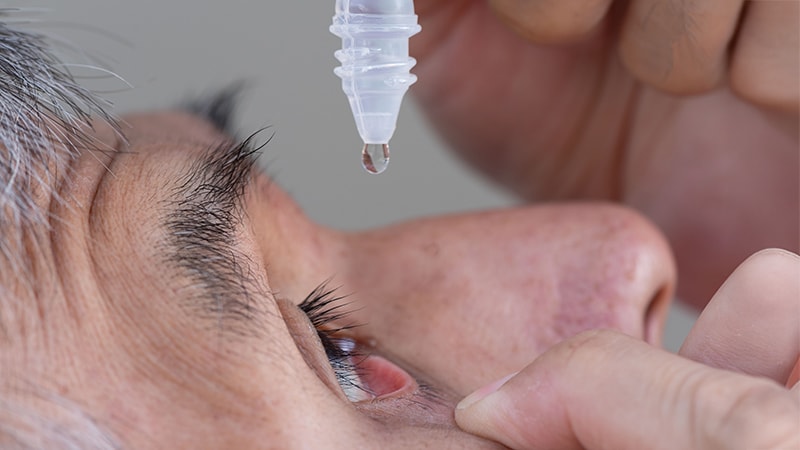TOPLINE:
Continuous use of tear substitutes significantly improved dry eye symptoms in patients with neovascular age-related macular degeneration (AMD) who received frequent eye injections, whereas intermittent use showed no significant improvement.
METHODOLOGY:
- A prospective randomized study, conducted across two hospitals in France, assessed continuous and intermittent use of tear substitutes in 65 eyes of 65 patients with neovascular AMD (mean age, 83.1 years; 57% women) who received anti-VEGF intravitreal injections for at least 1 year at 4- to 8-week intervals.
- Participants were randomly assigned to receive either continuous treatment with 0.18% sodium hyaluronate eye drops four times a day (n = 32) or intermittent treatment with 1.5% povidone artificial tears for 3 days after each intravitreal injection (n = 33). Patients were assessed over four consecutive injections.
- The primary endpoint was the mean change in scores on the ocular surface disease index (OSDI) questionnaire, used to assess dry eye symptoms and their impact, from baseline to after four intravitreal injections.
- Secondary endpoints included changes in tear breakup time, scores on the Schirmer test, and Oxford staining.
TAKEAWAY:
- Continuous treatment with 0.18% sodium hyaluronate significantly improved OSDI scores by a mean of -6.6 points compared with intermittent treatment, which showed a mean change of +0.6 points (P = .04).
- The proportion of patients with a reduction in OSDI scores of at least 10 points was higher in the continuous treatment group than in the intermittent treatment group (48.1% vs 20.0%; P = .02).
- No significant differences were observed in scores on the Schirmer test, tear breakup time, or Oxford staining from baseline to after four intravitreal injections between the continuous and intermittent treatment groups.
- Seven patients — five from the continuous group and two from the intermittent group — dropped out of the study for reasons such as blurred vision, poor tolerance, and difficulty administering the drops.
IN PRACTICE:
The findings “support the potential benefit of the continuous use of artificial tears to improve long-term tolerance in patients receiving frequent injections, and potentially also in the short term,” the researchers of the study reported.
SOURCE:
The study was led by Héloïse Torres-Villaros, MD, of the Ophthalmology Department at the Avicenne Hospital, Sorbonne Paris Nord University in Bobigny, France. It was published online July 22, 2025, in Ophthalmology and Therapy.
LIMITATIONS:
The sample size of the study was small. The use of different treatments in the two groups made it difficult to attribute benefits to specific components. The lack of multivariate adjustment meant that residual confounding factors could not be excluded.
DISCLOSURES:
No funding or sponsorship was received for this study. Three authors disclosed receiving personal fees from various sources, including Bausch & Lomb, Horus Pharma, and AbbVie.
This article was created using several editorial tools, including AI, as part of the process. Human editors reviewed this content before publication.
Source link : https://www.medscape.com/viewarticle/continuous-use-tear-drops-eases-dry-eye-symptoms-age-related-2025a1000jp7?src=rss
Author :
Publish date : 2025-07-25 10:19:00
Copyright for syndicated content belongs to the linked Source.
